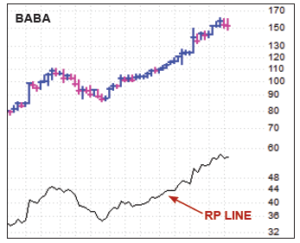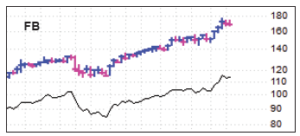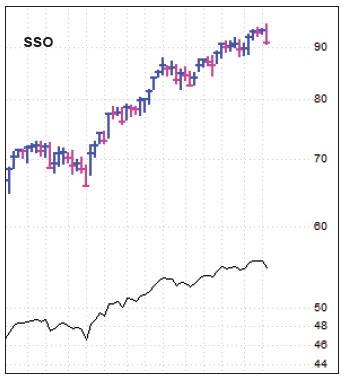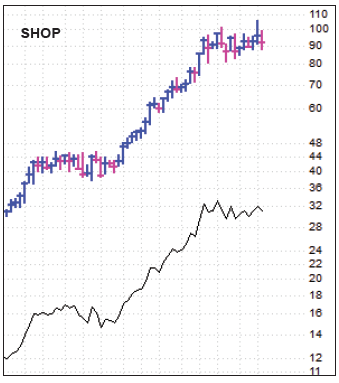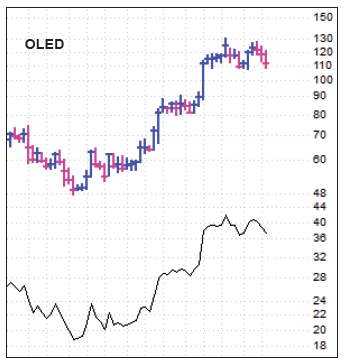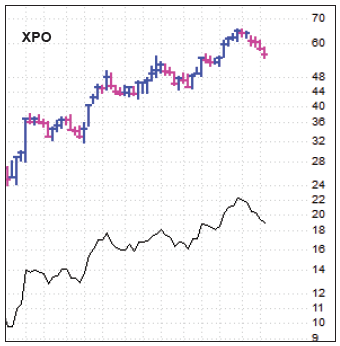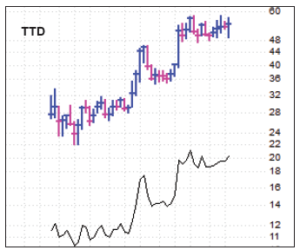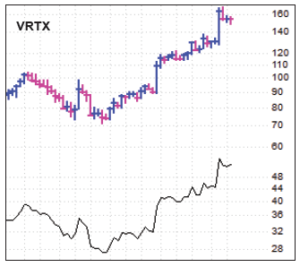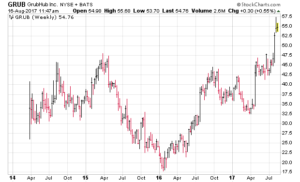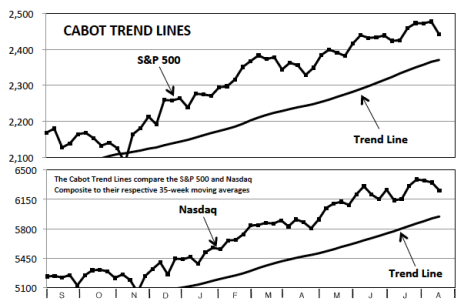In tonight’s issue we write about one stock that’s at the top of our Watch List, as well as the value of letting a stock make decisions for you. We also give you our latest thoughts on the market, our stocks and some new ideas.
Cabot Growth Investor 1374
[premium_html_toc post_id="137519"]
Summer Squall or Serious Storm?
After a lackluster June for growth stocks, July saw a low-volume rally, generally led by blue chip stocks. Some liquid leaders did lift to new highs, but many leaders and the Nasdaq ended up stalling out, even as the Dow put together 10 straight up days and took the 22,000 level.
Then came last week, when the music stopped, at least for the time being. All five of the major indexes we track dove below their 50-day lines, causing our Cabot Tides to flash a sell signal. And our Two-Second Indicator joined in on the bearish action, with the number of stocks hitting new lows surging in recent days. We sold our weakest stock and upped our cash position to 32%.
After nine months since the last market downturn, it looked like the sellers had finally taken control for a while. Until this week! Since last Thursday’s sell signal, the major indexes have bounced nicely (three of the five have snapped back above their 50-day lines), and many growth stocks have popped higher, too.
So where does this leave us? Was last week’s decline a brief summer squall that’s already passed, or, given weeks of sloppy action, was it the start of a severe, sustained storm?
Proof that it was just a summer squall could come from a “whipsaw buy signal,” which occurs when a Tides sell signal is reversed within a few days. Combined with our still-bullish Cabot Trend Lines, the obvious reason for the selloff (North Korea) and elevated levels of fear (the 15-day average of the put-call ratio hit its highest level in 13 months; see chart), a continued snapback would be a strong sign that last week’s sharp dip was a shakeout.
That said, the damage done to growth stocks (during earnings season) and the market (last week) hasn’t been wiped away by the recent bounce. We think the next big couple of days could tell the tale—if the market falls apart, we’ll hold our cash and honor our stops, but if the bulls step up and our Tides return to positive territory, it will be time to do some new buying.
[highlight_box]WHAT TO DO NOW: Right now, it’s best to let the market show its hand. Last week, we took our profit in XPO Logistics (XPO), leaving us with nearly one-third in cash, but are ready to play either the buy or sell side going forward, depending on what the evidence shows.[/highlight_box]
Model Portfolio Update
Two keys to successfully managing your portfolio are patience and flexibility. You have to have enough patience to wait for solid setups (and to give your winners a chance to continue advancing despite short-term hiccups), which we happily did in recent weeks as we held off new buying—growth stocks were acting sloppy, and the Nasdaq stalled out after a low-volume July rally.
But you also have to be flexible, which means changing your stance based on the evidence. Last week’s Tides sell signal caused us to sell our weakest stock (XPO), resulting in nearly one-third of our portfolio in cash. Now, though, we’re staying on our toes should the market’s bounce result in a whipsaw buy signal.
All told, the next few days should be important—a good couple of days would be bullish (and could have us putting cash to work), but renewed weakness would cause us to hold our cash and keep some tight stops in place. Stay tuned.
Current Recommendations
BUY—Alibaba (BABA 160)—BABA broke down through its 25-day line for the first time all year last week, but buyers appeared near the 50-day line on Friday and have pushed shares back toward their highs. Overall, the stock remains in good shape and has mostly moved sideways during the past month or so. But earnings are out tomorrow (Thursday, August 17) before the open, which will have a lot to say about the stock’s intermediate-term future. (Analysts are looking for revenues to have grown 48% while earnings of 93 cents per share should be up 27% from a year ago.) We’re not ruling any possibility out given the rough earnings season for growth stocks, but with our profit cushion, BABA’s relatively recent breakout to new post-IPO highs and its status as a liquid leader, we’re aiming to hold through any near-term weakness, thinking the stock’s overall run is still in the early innings. Right now, sit tight if you own some, and we’ll have an update if need be after we see how big investors react to the quarterly report, conference call and guidance.
BUY—Facebook (FB 170)—FB took last week’s sharp selling in stride; in fact, if you look at the chart you’ll have a hard time spotting last week’s market dip. Fundamentally, the firm has started a soft launch of TV-like video features (some U.S. users now have a “Watch” tab on their Facebook pages) with short-form content from some firms like Time and Major League Baseball, with longer-form content (including Friday night baseball games) debuting in the future; if all goes well it could make the platform even stickier and create a ton more advertising opportunities. Back to the stock, FB has basically marked time since its big run from 148 to 173 in July, a sign that big investors are hesitant to let their shares go despite the market’s wobbles. Continue to sit tight if you’re already in, and if not, you can start a position (maybe buy half the amount you normally would), preferably on dips into the 167 area.
BUY—PayPal (PYPL 60)—PYPL is another liquid leader that has barely budged since a solid run-up during the first three weeks of July. While the short-term outlook will depend on the market, we think the stock is a good buy around here as the 25-day line has caught up to the stock and there’s solid support in the mid 50s. On the business front, it looks like PayPal is making a move into the lending business, acquiring a private firm that provides loan underwriting for small businesses. We’ve seen many companies (like Shopify and Square) move into this space as big banks are focusing on high-quality, larger borrowers, leaving an opportunity for many small business facilitators to help with working capital. (PayPal has 17 million merchant accounts among its 210 million.) Overall, we remain very bullish on PayPal’s position at the heart of the digital payment movement and are encouraged by the stock’s calm action, so go ahead and start a position if you’re not yet in
HOLD—ProShares Ultra S&P 500 Fund (SSO 93)—We placed SSO on Hold last week when the Tides turned negative, but the S&P 500 quickly shot back above its 50-day line, and some other key indexes have as well—a possible whipsaw buy signal, as we wrote about on the front page. Even so, one good up day after a few bad ones doesn’t necessarily tell us the sky is clear. We’ll stay on Hold, but a major show of strength from the bulls would likely have us going back to Buy (and offer up a solid entry point for those that don’t own SSO).
HOLD—Shopify (SHOP 95)—After basically doubling in price during the first half of the year, SHOP needed a rest, and we think that’s the main reason (along with the market) for the stock’s sloppy action of late. Shares did pop to new highs following earnings two weeks ago, but quickly slid back into the consolidation area they’ve occupied since mid-May. However, big picture, the fact that SHOP hasn’t pulled back much in recent weeks is a positive sign. Plus, with the firm’s top-line numbers looking great and sub-metrics like client growth (another record quarter of merchant additions in the second quarter), recurring revenue ($23.7 million per month in June, up 64% from a year ago) and uptake of its more expensive offerings like Shopify Plus (which account for 18% of recurring revenue, up from 13% a year ago) all racing ahead, we continue to think SHOP has another leg up, possibly a big one, down the road. It’s not strong enough for a Buy rating, but if you have a good profit and have taken some chips off the table, we advise using a loose stop (somewhere in the upper 70s, most likely) and practicing patience.
HOLD—Universal Display (OLED 114)—Universal Display reported a great quarter two weeks ago, but the stock slid anyway, partly due to the weakness in growth stocks, partly due to a smidge of conservatism from management in the conference call (they were bullish but said the timing on certain OLED material purchases is hard to nail down) and possibly partly due to war fears in Korea, as Samsung and LG are the company’s two largest customers. That said, OLED hasn’t yet done anything wrong—shares have traded between 107 and 125 for all but a couple of days since mid-May, and so far, the stock has found support near the lower end of that range. A decisive drop to the mid 100s would make the past few months look like a big top and likely have us bailing, but we’re aiming to give shares every chance to hold up as the fundamental story remains as big as ever. Encouragingly, analysts hiked their estimates following the quarterly results to $2.14 per share this year (up from $1.84 before the report) and $2.82 next (from $2.55).
HOLD—Veeva Systems (VEEV 64)—Cloud software stocks in general have been so-so in recent weeks, with few making much progress, but with many set to report earnings within the next couple of weeks. (Veeva’s report is due out after the market close on August 24.) VEEV is now 12 weeks into its consolidation, and so far there’s good (numerous shakeouts to the 60 area have found support) and bad (very high-volume selling in early June) to the structure. Thus, it’s likely the quarterly report is going to make or break the uptrend. A decisive drop below 58 or so would make the chart look toppy and prompt us to take our modest profit and move on, but any push above 68 could be the “go” signal for a resumption of the rally. Fundamentally, there’s a ton to like here, but (as we write later in this issue) we’ll simply let the stock make the decision for us. Hold for now.
SOLD—XPO Logistics (XPO 56)—When our Cabot Tides flashed a Sell signal last week, we looked for our weakest stock to sell, and found XPO. Whether it was because of uncertainty surrounding a future acquisition, a so-so second-quarter report or a large share offering, XPO has been sagging since late June and fell all the way back to its breakout level from early May. The story is still excellent, but we took our profit last week and think there will be faster horses to ride once the bulls retake control.
Watch List
Exact Sciences (EXAS 39): EXAS has had to deal with a choppy biotech sector, a weak market, a negative report from a short-selling outfit and a big share offering in recent months. But the stock remains near its highs and revenue is growing at triple-digit rates.
Exelixis (EXEL 27): If biotech stocks can get off their duff, EXEL is poised to be a leader—it’s basically a one-product company, so there’s risk, but growth is outstanding, profits are booming, the firm is debt free and the stock is set up nicely.
GrubHub (GRUB 55): We think GRUB has entered a sustained uptrend as competitive fears ease. See our write-up later in this issue.
iRobot (IRBT 102): iRobot is the leader in robotic vacuum cleaners, which make up just 20% of the industry’s sales. The top and bottom line are expanding nicely and the stock is tightening up near its peak.
ServiceNow (NOW 110): We’re glad we haven’t pulled the trigger yet on NOW, which has flopped around during the past couple of months. But if it can build some upside momentum after last week’s shakeout, it could be ready to run.
Other Stocks of Interest
The stocks below may not be followed in Cabot Growth Investor on a regular basis. They’re intended to present you with ideas for additional investment beyond the Model Portfolio. For our current ratings on these stocks, see Updates on Other Stocks of Interest on the subscriber website or email mike@cabotwealth.com.
Planet Fitness (PLNT 24) — New Hampshire-based Planet Fitness runs a string of over 1,400 fitness centers, including 37 that opened during the second quarter. The company’s strategy is to target casual and first-time gym users with a non-intimidating atmosphere and a cheap ($10 per month) user fee. Q2 results reported last week featured 17% revenue growth, 9% growth in same-store sales (which continues a string of 42 consecutive quarters with positive same-store sales growth) and earnings growth at 29%. The company is growing with both corporate-owned and franchised locations, and sales of equipment to existing franchisees and for new store openings account for more than 40% of revenues. This looks like a cookie-cutter story with a long growth pathway ahead; management expects 1,000 new openings over the next five years alone!
Trade Desk (TTD 51) — Trade Desk is transforming the world of advertising, giving ad buyers a platform on which they can create, manage and optimize data-driven digital advertising campaigns. Ads can be targeted at TVs, laptops or mobile devices via display ads, videos or social media posts. The company has posted triple-digit earnings growth in six of the last 10 quarters (including Q1 and Q2 2017) and revenue growth is nearly as large, up 78% in 2016, up 76% in Q1 and 54% in Q2. The stock is still pretty young (IPO was in September 2016) and institutional investors are piling on board. Trade Desk is already a leader in the U.S. and has been booking ridiculous growth rates—372% in Seoul, 279% in Tokyo, etc.— outside the U.S. TTD is currently stuck in a three-month trading range; a breakout above 58 would be bullish.
Vertex Pharmaceuticals (VRTX 151) — Vertex Pharmaceuticals specializes in treatments for cystic fibrosis (CF) and certain kinds of cancer, and news from clinical trials has been good. July brought news that three different triple combination drug regimes might have the potential to treat the underlying cause of CF. VRTX has been a leading biotechnology stock, pushing from 73 in January to over 150 in recent trading. While VRTX trades at a pricey 118 P/E, analysts see earnings growing at 88% this year and 89% in 2018, which is exactly the kind of growth that can fuel future gains. The recent pullback in VRTX is normal, and if it can tighten up, it could be in a great position to get going again.
Weibo (WB 88) — Weibo is one of the most popular social media sites in China. It’s a lot like Twitter (including the 140 character limit), but Chinese characters can carry a heck of a lot more meaning than 140 English letters. The company also offers games and celebrity sites, and generates revenue through advertising and marketing. With 11 straight quarters of triple-digit earnings growth and revenue growth of 67% and 72% in Q1 and Q2, respectively, there’s enormous growth to build on. After a big gap up following May earnings, WB traced a V-shaped correction and has been choppy after the company August 9 Q2 report. It’s a tricky stock to handle, but there aren’t many companies out there with this kind of growth. Let’s see if it can settle down and offer up a lower-risk entry.
GrubHub (GRUB)
Perception is Changing!
We’ve long loved the mass market potential of GrubHub—the company is the top player in online food ordering, which works well for consumers (having dozens of options in many markets in the U.S. all on one website) and restaurants (who get additional orders and revenue without having to pour money into extra advertising).
The company has even dived headfirst into delivery services during the past year, which, though adding cost, has allowed it to add some major chains to its platform, and provide delivery for them; it offers delivery services for more than 1,000 Subway locations, for instance.
Despite a non-stop stretch of rapid revenue growth and healthy earnings and cash flow growth, the stock was unable to make any net progress from its post-IPO peak in the spring of 2015. The reason? Fears of competition. While GrubHub was a leader, there were many competing services popping up (including delivery services), and the firm had no real barriers to entry. That seemed to keep big buyers from building positions.
We believe that’s changing thanks to GrubHub’s recent moves on the M&A front. First, the company bought Foodler in early June, a leading online food ordering platform (about $80 million of annualized gross food sales and 8.8 million active customers), especially in the Northeast.
Then came a strategic partnership with Groupon, where GrubHub will effectively take over Groupon’s OrderUp food delivery service. And finally there was a big deal with Yelp, with GrubHub buying that company’s Eat24 food ordering subsidiary (for $288 million in cash), while Yelp will integrate online ordering from all of GrubHub’s restaurants onto its platform.
The message of these deals is simple: Competition is easing, GrubHub is now the clear leader in its industry (four times the size of its nearest competitor) and, thanks to the network effect, it should grab a disproportionate share of new restaurants, new diners and (of course) revenue.
Growth has already been solid (revenue rose 32% in Q2), though cash flow growth has slowed as the company continues to invest in its platform. But the stock has responded in a big way. After meandering sideways for the past few months, GRUB exploded to new all-time highs on three straight days of excellent volume.
Of course, there are still possible competitive threats (Amazon has been rumored to be interested), but the combination of GrubHub’s recent deals and the stock’s action (even in the face of a tricky market) are a good sign perception has changed for the better. We have GRUB on our Watch List are are hoping to add it to the Model Portfolio once the market gives us an all-clear.
Let the Stock Make the Decision For You
One thing we see time and again is that as soon as a stock takes a hit, whether it’s because of the market, earnings or some other reason, we get a handful of emails asking whether it should be sold. In fact, we often get a few worried emails after a stock simply sits around for three or four weeks.
In most cases, sudden declines and choppy periods are normal action within an overall uptrend. But our bigger piece of advice is that, when you’re unsure about a stock (or the market), it’s best to let the stock make the decision for you.
How? By setting a mental stop below some recent support (or honoring your loss limit, if you don’t have a profit), and then sitting back and seeing what happens.
Most investors don’t want to “set it and forget it”—instead, they want to tinker and predict what’s going to come. But letting your stocks make the decision usually results in better performance because you’re trading based off market action; you’ll tend to hold your strongest stocks during market shakeouts, while ditching those that are losing sponsorship.
Of course, that doesn’t mean you have to be a robot about things. If, say, the market weakens in a major way, you can tighten some stops and even sell your weakest stock or two outright. You always want to alter your game plan as the evidence changes.
But the major point is that agonizing over every wiggle in every stock you own will usually do more harm than good. As we’ve done in the Model Portfolio with stocks acting a bit suspiciously (like OLED and VEEV), you’re better off choosing a reasonable line in the sand and then letting the stock tell you whether it should stay or go.
Cabot Market Timing Indicators
It’s still a bull market, but it’s clear that there are some cracks in the armor—the broad market has suffered in recent weeks while the Cabot Tides are on the fence. It’s no time to sell wholesale, but we’re waiting for decisive strength before concluding the major uptrend is resuming.
Cabot Trend Lines: Bullish
Our Cabot Trend Lines are still in good shape despite some ups and downs during the past couple of months, with the S&P 500 and Nasdaq Composite closing 3% and 5.2% above their respective 35-week moving averages last week. Thus, near-term issues aside, the overall bull market is intact, with the odds favoring higher prices in the months ahead.
Cabot Tides: Bullish
Our Cabot Tides are in an interesting spot—they flashed a sell signal last week as all five of the indexes we track (including the Nasdaq, shown here) dove decisively below their lower (50-day) moving averages. But the snap back this week has pushed three of the five indexes just above their 50-day lines. For now, we’d rather be safe than sorry, but the next few days should tell us whether last week was a shakeout or the start of a larger decline.
Two-Second Indicator: Healthy
Just when it looked like the broad market had gotten its act together, our Two-Second Indicator began recording a huge, steady increase in the number of new lows—and those readings began right as the Dow first leapt over 22,000! That’s a red flag, though given the on-again, off-again readings from this indicator all year, we’re focused more on our trend-following measures and the action of leading growth stocks.
[premium_html_footer]
Send questions or comments to mike@cabotwealth.com.
Cabot Growth Investor • 176 North Street, Post Office Box 2049, Salem, MA 01970 • www.cabotwealth.com
All Cabot Growth Investor’s buy and sell recommendations are made in issues or updates and posted on the Cabot subscribers’ website. Sell recommendations may also be sent to subscribers as special bulletins via email and the recorded telephone hotline. To calculate the performance of the portfolio, Cabot “buys” and “sells” at the midpoint of the high and low prices of the stock on the day following the recommendation. Cabot’s policy is to sell any stock that shows a loss of 20% in a bull market (15% in a bear market) from our original buy price, calculated using the current closing (not intra-day) price. Subscribers should apply loss limits based on their own personal purchase prices.
Charts show both the stock’s recent trading history and its relative performance (RP) line, which shows you how the stock is performing relative to the S&P 500, a broad-based index. In the ideal case, the stock and its RP line advance in unison. Both tools are key in determining whether to hold or sell.
THE NEXT CABOT GROWTH INVESTOR WILL BE PUBLISHED AUGUST 30, 2017
We appreciate your feedback on this issue. Follow the link below to complete our subscriber satisfaction survey: Go to: www.surveymonkey.com/marketlettersurvey
Neither Cabot Wealth Network nor our employees are compensated by the companies we recommend. Sources of information are believed to be reliable, but are in no way guaranteed to be complete or without error. Recommendations, opinions or suggestions are given with the understanding that subscribers acting on the information assume all risks. © Cabot Wealth Network. Copying and/or electronic transmission of this report is a violation of U.S. copyright law. For the protection of our subscribers, if copyright laws are violated, the subscription will be terminated. To subscribe or for information on our privacy policy, call 978-745-5532, visit www.cabotwealth.com or write to support@cabotwealth.com.
[/premium_html_footer]



